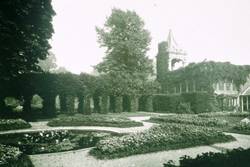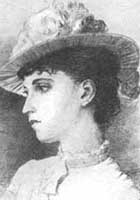We decided to have an easy day today and walked to Holland Park.
Along the way to the park, we pass a statue in front of a building associated with Ukraine.
This is St Volodymyr ruler of Ukraine from 980 to 1015
St. Volodymyr, ruler of Ukraine 980-1015, erected by Ukrainians in Great Britain in 1988 to celebrate the establishment of christianity in Ukraine by St. Volodymyr in 988.

This location is next to the main gate of the public park, Holland Park.

The London Wlogger has some great pictures of Holland Park. Well worth looking at. The first half of this blog has pictures only of Holland Park. Among them are photographs of the forest and other sections of the park.
History
Holland Park is spread across 54 acres of what used to be the grounds of Cope Castle, a large Jacobean mansion hidden in the woods. It was built by Sir Walter Cope in the early 17th century, who became Chancellor of the Exchequer under King James 1. It was renamed Holland House after the Earl of Holland’s wife Lady Rich inherited the property.

Holland House was badly damaged during World War II. One wing was saved and is used as a youth hostel. A remaining section of the front terrace is now used as a distinct backdrop for the park's summertime open-air theatre productions and classical concerts.
Finding us
The park is easily accessed via
Kensington High Street underground station:

This is just one of the wonderful pictures of Holland Park posted by the London Wlogger.
Immediately inside the park plants, trees and bushes grow in abundance.
Tiny waterfowl getting their "feet wet" without parental supervision.
From afar this looks exactly as if someone is nurturing a bonsai tree. I suspect it is simply the old tree trying to regenerate itself.
Waterfall in Kyoto Garden inside the park.
Holland Park Kyoto garden was designed and built by an eminent Japanese Garden designer and his team to celebrate the Japan Festival in London in 1992. It was a co-operative project between the Royal Borough of Kensington and Chelsea and the Kyoto Chamber of Commerce in Japan.
Practising for the acrobat show? Exercising? Or possibly just showing off.
Small shrine in the garden

The Kyoto Garden in this park is in the “tour garden” style, one of the typical traditional garden styles of Japan. The trees are trimmed with special care to emphasise their natural shapes to make the most of the original lines of their trunks and branches. The three-step waterfall symbolises steep mountains and deep gorges, while the pond depicts a vast ocean view. In this way, the entire garden represents, in condensed form, the grandeur of natural landscape. The pond is graced with garden paths and a stone bridge. Along the path, toro (stone lanterns), tsukubai (a stone washbasin) and shishiodosi (a bamboo alarm for animals) are positioned at appropriate places to please visitors. All of these features are carefully arranged so that visitors may enjoy the seasonally changing atmosphere and landscape of the garden. The garden has a unique beauty. Time is an element that adds to the garden’s natural beauty. The climate affects the original design over the years, making the garden’s landscape even more natural and fitted to its locality.
One of the many attractions in Holland Park is the little flock of peacocks.
This male was not only spreading his tail but was doing a little dance with his body as well.
We have never seen a female in the park before, and the peahen was not impressed with the exhibition put on by the male. She took no time leaving that park area and being a very modest bird, she disappeared.
I do not remember the significance of the Walking Man and so far have not found anything but photos of him online. The picture does not really show it but apparently lots of people are in the habit of rubbing his boot toe for good luck.
In Henry's distinctive style, Walking Man shows a painterly application of colour and liberal evidence of the modelling process. The figure remains emotionally controlled, daydream-like, and serene. The effect of making this sculpture slightly larger than life distances the figure from the spectator, making this otherwise unremarkable object - remarkable. By shrouding Walking Man in plain dress, Henry prompts us to view his ostensibly realist figure not as representative of a physical reality, but as a vehicle for questioning our existence; by asking the spectator to search for something more.

A completely different peacock than the one we saw earlier.
This adventurous bird was trying to get into the building. However, a moment later, a woman came and shooed him away and closed the door.
Fountain in the "Italian" garden

It's all about understated simplicity in Holland Park. William Pye's 1999 fountain Sibirica graces a pond in the iris garden.
Rose garden
Fountain with mural in the background.

The murals depict an afternoon in the 1870s when a garden party is in progress. The social elite sit around as casually as they can in formal wear and make the most of a pleasant day. Some of them look like they’re enjoying it more than others.
Mural of a garden party given by the Earl of Ichester.
Along with wonderful reproductions of the mural, this site has advice for the interested reader.
There are quite a few books on Holland House and the Park but I would recommend The Pleasure Grounds of Holland House by Sally Miller for a detailed description of the history of the estate grounds and the Famillies of Holland House by Carolyn Starren for a history of the occupants of the house. Both of these were published in 2012 by Scotsforth books for the Friends of Holland Park.
Mural along an arched covered wall.
These murals show an imaginary scene from one of the garden parties which used to be held by the Earl of Ilchester in the grounds of Holland House in the 1870s. The costumes were carefully researched and
the artist has included portraits of many of the Friends of Holland Park (who commissioned the murals) and their friends, so that each face is of a different and real person.
I do know how to dress myself and brush my own hair. It just doesn't look like it on
this very windy/blustery day.
The house was damaged in a bombing raid in WW II. Rather than restore the house, the grounds became home to a theatre where opera is preformed.
Photographs of the house and grounds before WW II
This huge Russian olive tree looks similar to ones that used to grow in our backyard. It has that telltale sage green appearance that our family is accustomed to.
We came across this chair by accident. Naturally I had to try it out.
Lunch at our local Pizza Hut. Five days a week it offers a buffet at lunchtime. Not only is a variety of pizza available, but they have a large salad bar as well.
Walking home we stopped to take a picture of a Royal Mail letter box. Not at all like the slim metal blue ones that we are familiar with in the US.
The mailboxes are locally referred to as pillar boxes.There are two slots to put mail into. One is for local or foreign mail while the other is for "franked" mail. We could refer to the mail at metered mail.
Franked reminds me of many of the English novels I have read.
Cast iron cap of a PB42/1 sits atop the box and is secured by bolts
A building we pass almost every day.
Spanish Catholic chaplaincy
Spanish home
Alice Christiana Gertrude Meynell (née Thompson; 11 October 1847[2] – 27 November 1922[3]) was an English writer, editor, critic, and suffragist, now remembered mainly as a poet.



47 Palace Court
A notice that there will be no parking on certain days.
Stairwell and glass windows in 27 Palace Court
Every flight of stairs is in two sections.
Our bathroom window. The wind blew so hard yesterday that it knocked the cups of the ledge.
Fortunately, they fell inward onto the floor.Outside the window is one of those mysterious empty wells found in buildings like this. If the cup had fallen four flights down to the ground, we don't think we would ever see it again. There is scaffolding built outside of this window and another structure of scaffolding on the other side of the building where the stairs and glass windows are. It reaches up to the fifth floor. We think that the scaffolding has something to do with plumbing issues in the two houses.
Today's BBC forecast:
London and South East England
Forecast Summary
Today
Bright and breezy this morning, with some warm sunny spells. Then becoming cloudy from the west this afternoon, with outbreaks of rain reaching western areas later.Tonight
Cloudy with outbreaks of rain, already across western areas, spreading sporadically northeastwards. Some heavier bursts of rain are possible before becoming mainly dry later tonight.








































































No comments:
Post a Comment